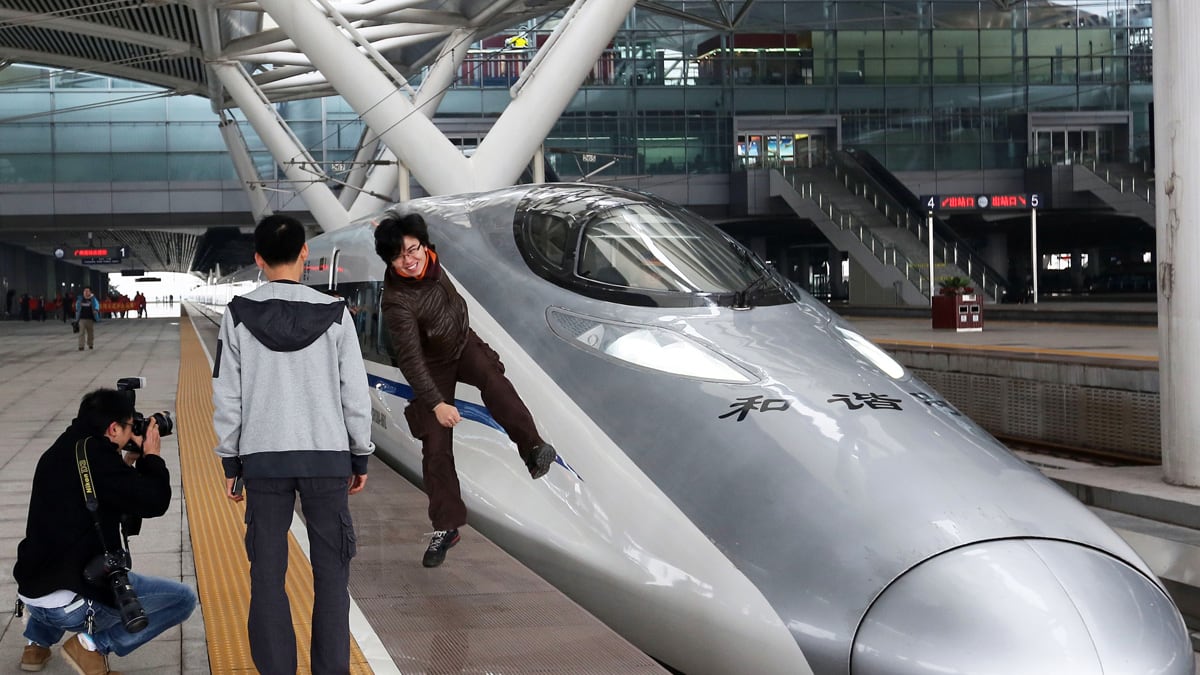The recent launch of China’s Beijing-Guangzhou high-speed rail—the longest high-speed line in the world—is more than a technological triumph. It’s also a much-needed propaganda boost for the country’s Railways Ministry, buffeted in recent years by fatal accidents, high-level scandal, and skepticism about safety standards

Trains have played an iconic role in the Chinese zeitgeist, especially for the nation’s leaders. The late Mao Zedong’s favorite mode of travel was by train. (He often enjoyed the company of young female attendants in his private car.) For much of the post-Mao period, the Communist Party’s top ranks were dominated by men trained as engineers; they dreamed of a national network of glittering train tracks uniting their domain, from the Pacific to the Himalayas. Moreover, the speed and mobility of train travel placed huge prestige on Beijing’s ambitious high-speed rail project, launched in 2008, which set out to build tens of thousands of kilometers of high-speed rail criss-crossing the country by 2020.
Saluted by attractive train attendants wearing high-collared burgundy coats and beret-style hats with the railway logo, a sleek white CRH380A (L) bullet train, emblazoned with navy speed stripes, pulled out from snowy Beijing at 9 a.m. on Dec. 26. Within 15 minutes it had reached cruising speed of 300 kilometers per hour. By 5 p.m., the train had snaked into the southern industrial hub of Guangzhou, 2,298 kilometers away, met by flowering shrubs and temperatures 20 degrees higher than in at its wintry point of origin.
The high-speed journey through five provincial capitals now takes eight hours, compared with the 22-hour trip on older, conventional trains. First-class tickets cost the equivalent of $221, more expensive than an economy-class air ticket. Although the plane ride is only three hours long, riding the rails appeals to business travelers tired of the hassles of air travel, including the frequent delays that have infuriated passengers so much that riots have broken out at airline counters. “A journey on the train is more pleasant,” businessman Yang Zengyu told local media after taking the newly inaugurated train. “Even for frequent fliers like me, It’s an attractive alternative.” The main drawback, he said, was the lack of reliable Internet access on the train.
The opening of the Beijing-Guangzhou line is also an important psychological marker. China’s rail sector had been under a cloud since a fatal high-speed train accident in July 2011 killed 40 people and raised questions about whether the headlong rush into high-speed rail development allowed for adequate safety testing. The Railways Ministry ordered a safety review of all projects under construction, and train speeds were slowed from 350kmh to 300kmh—a regulation that remains in force. Pending projects also were suspended during the post-crash period, and the opening of the Beijing-Guangzhou line was delayed by a year. Earlier that year, in February 2011, Railways Minister Liu Zhijun had been purged in a major corruption probe, tarnishing his ministry and the high-speed rail campaign that had been his pet project. He was expelled from the party in May 2012.
Now, with the successful opening of the Beijing-Guangzhou line, the high-speed campaign is back on track. Many suspended projects have resumed construction, and the ministry has secured $96 billion in investment for rail infrastructure next year. Railways Ministry transport bureau deputy head Zhao Chunlei announced that the country’s network of high-speed lines, linking secondary routes to major ones, are on schedule for completion by 2015—and by 2020 the nation’s rail system will include 120,000 kilometers of track that connect all provincial capitals and cities with populations exceeding half a million. The high-speed lines “will enhance economic integration of cities along the line,” Tian Xuebin of the Hebei University of Economics and Business told the China Daily.
Even as Beijing’s high-speed rail development forges ahead, however, the network connects a nation riven by economic and educational disparities. In December, bullet trains on high-speed rail lines in northwest China were forced to slow down seven times in three days because of passengers who lit up cigarettes, despite a smoking ban. Apparently many of them assumed smoking is allowed in the sleek bullet trains, as it’s permitted in the connecting platforms between the cars of ordinary trains. In August 2011, several railway police officers and conductors had to apologize to passengers after they were caught smoking in the sightseeing car on a bullet train from Shanghai to Beijing.
Meanwhile, an uptick in the feistiness of civil society has triggered a number of questions and complaints from ordinary citizens about high-speed rail projects. Residents in some Beijing communities raised objections to a new high-speed rail project, due to begin construction in June, that will link Beijing and the northern city of Shenyang. The residents are jittery about safety and noise; on Dec. 9 about 300 protested to ask the government to change the proposed route. The critics also complained that an environmental impact assessment published online was wrong to state that almost 40 percent of residents surveyed had expressed approval of the route. The Railways Ministry responded in a statement, “Construction of the Beijing-Shenyang rail line will not begin unless a solution can be agreed on by most of the residents.”

Last but not least, some of the biggest rail travelers—China’s rural-born migrant workers who work far from home—are finding the cost of high-speed rail tickets too high. “High-speed rail tickets are unaffordable for most migrant workers, so the railway authorities should operate more low-speed rail lines during travel peak periods,” Shuai Bin, a professor at the School of Traffic and Logistics at Southwest Jiaotong University, told the China Daily.
Authorities will be doing just that during the 40-day “spring festival travel period,” which begins in late January. Many Chinese migrant workers will head to their rural hometowns during the longest and most important vacation of the year, the weeklong lunar New Year holiday. The number of rail trips taken during this period usually exceeds China’s 1.3 billion population—in 2008 the figure hit 2 billion. Every year, the travel crush presents a huge challenge to China’s rail system, as it tries to cope with the biggest annual human migration in the world.





